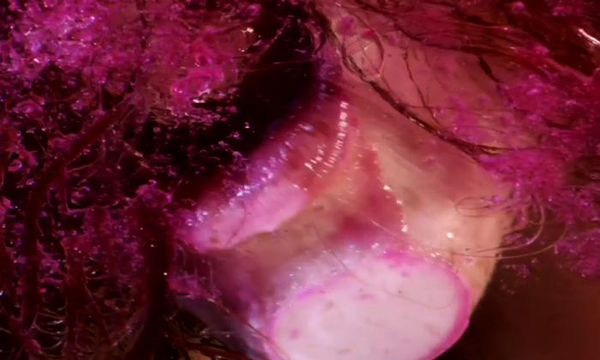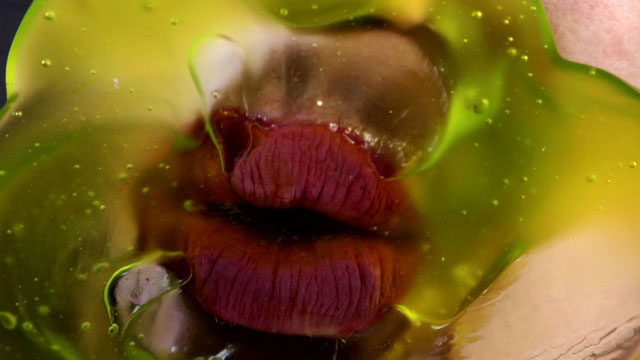
Florian Maier-Aichen, "Above June Lake," 2005, C-print
If I were to name art’s King and Queen of sleek professionalism, Florian Maier-Aichen and Marilyn Minter would take the crowns. They compliment each other, Maier-Aichen bringing out Minter’s reliance on textured terrain and Minter reminding us that Maier-Aichen works within a bodily lexicon. But the artists belong together because they both obfuscate fact expertly. They produce such seductive pictures of the world (tongues swooshing amidst jewels, landscapes crusted in blood-red soil) that my first reaction is to guilelessly fall into the illusion they’ve fashioned. Yet the illusion is so shallow—really, Maier-Aichen and Minter work only with surfaces—that I can’t fall far. It’s a funny paradox: fantasies have to be carefully manufactured and refined before they become fantastic. Then once presented, glossily produced spin-offs on human desire supposedly let us access our raw, innermost selves, as if looking into what we want leads us to who we are.
Unfortunately, it doesn’t usually work that way. Fantasy is notoriously disinterested in authenticity, which is precisely why I find the story behind Marilyn Minter’s Green Pink Caviar captivating. Apparently (I didn’t hear this account first-hand, but I’ve heard it often enough to embrace it), Minter had been thinking about painting with her tongue when she called up Ford Modeling Agency—who else would you call?—and asked for a long-tongued, full-lipped model. Ford sent Louisa Taadou, a slender girl from Marseilles whose lips are the heaviest feature on her otherwise wispy face. Louisa used her tongue, framed by carefully painted lips, to lick colorful pastries off of a glass surface while a camera watched from below.
This whole sequence of events evidences capitalism at its most abstract. Minter has an idea, she decides to execute it, and she calls an associate to request the services she needs. Her associate sends over the proper material—a girl who, upon understanding the task at hand, skillfully wills her anatomy to perform. No one questions the props, in this case the meringue and crumbs, lipstick and glass surface; all parties simply do their job. The resulting video and images, called Green Pink Caviar (a title that reveals little about Minter), do the professionalism that enabled them proud. The self-contained works of art co-opt the culturally determined standards of desirability on which they rely (fashion, confections, cosmetics). Cheeks and chins, flattened against glass, play into the rhythm of the crumbs and filling that move across the frame, looking too primordial to be edible. The lips, less hungry than obedient, do their job with requisite relish. Minter gets so close to her subject that it loses its identity and retains only sensuousness.
Here, it would be easy to turn to a conversation about feminism and objectification (a conversation certainly worth having in relation to Minter), but I’m more interested in what it means to fabricate fantasy through expertly co-opting particularities, which is where Florian Maier-Aichen comes in.
While Minter zooms in on her subject, Maier-Aichen pulls away, giving us a panorama that becomes unfamiliar in its completeness. While I attach Minter to the detail-oriented lexicon of fashion glossies, Maier-Aichen resonates with a different type of highly produced media: he works cinematically. His images are as scenically breathtaking as Lord of the Rings and as incisive as any Lars von Trier film, but divorced from context. In an untitled print from 2005, hills with the texture and color of red meat slope down to a warm asphalt freeway where cars become compositional motifs, telling our eyes where to travel. The asphalt, a curved gesture that pulls through the image’s frame, transitions down into rosy sand, the shape of which mirrors the adjacent ocean’s foam. The water itself, just green enough to bring out the bloodiness of the red terrain, crescendos, crowning the image with a saturated turquoise halo.

Florian Maier-Aichen, "Untitled," 2005, C-print. Courtesy of Blum & Poe.
Roland Barthes wrote, of a sentence from Bouvard and Pecuchet that seduced him, “I enjoy an excess of precision, a kind of maniacal exactitude of language, a descriptive madness.” I feel similarly about Maier-Aichen. It’s his precision that draws me in. His handling of color and shape turns a whole span of majestic landscape into a self-absorbed artifact. An image only interested in being an image, only interested in its own ability to seduce.
Yet what Maier-Aichen does, and what Minter does, holds little resemblance to the “art as art” discourse of modernist abstraction and much more resemblance to the professionalized world of advertising. That neither artist sells anything tangible (they’re not even selling any distinguishable ideology) makes their work disturbing. Minter and Maier-Aichen present as skillful manipulators rather than truth seekers. But their images, by being detached from authenticity, force me to grapple with truth. If I allow myself to be seduced by the sleek visual terrains the two artists confront me with, then am I rejecting what I know? Am I embracing a sort of nihilism? What bothers me immensely is that I want to occupy the self-absorbed, surface-level pictures that Minter and Maier-Aichen offer, but I don’t entirely understand why.
I do have one hunch, however: the aloofness of the fetishistic fashion shoots and the masterfully edited landscapes allows me to maintain a sense of my own professionalism. I am not a vulnerable, susceptible viewer. I am instead a collected connoisseur who is able to indulge in the sensual appeal of images without jeopardizing the firmly sophisticated self-image that is my own dearest fantasy.






Pingback: What’s Cookin at the Art21 Blog: A Weekly Index | Art21 Blog